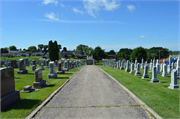Property Record
305 W MAIN
Architecture and History Inventory
| Historic Name: | Holy Ghost Cemetery |
|---|---|
| Other Name: | |
| Contributing: | Yes |
| Reference Number: | 232926 |
| Location (Address): | 305 W MAIN |
|---|---|
| County: | Grant |
| City: | Dickeyville |
| Township/Village: | |
| Unincorporated Community: | |
| Town: | |
| Range: | |
| Direction: | |
| Section: | |
| Quarter Section: | |
| Quarter/Quarter Section: |
| Year Built: | 1872 |
|---|---|
| Additions: | 1920 |
| Survey Date: | 2016 |
| Historic Use: | cemetery |
| Architectural Style: | NA (unknown or not a building) |
| Structural System: | |
| Wall Material: | |
| Architect: | |
| Other Buildings On Site: | |
| Demolished?: | No |
| Demolished Date: |
| National/State Register Listing Name: | Not listed |
|---|---|
| National Register Listing Date: | |
| State Register Listing Date: |
| Additional Information: | A 'site file' titled 'Holy Ghost Parish Historic District' exists for this property. It contains additional information such as correspondence, newspaper clippings, or historical information. It is a public record and may be viewed in person at the Wisconsin Historical Society, State Historic Preservation Office. Original cemetery site dates to the founding of the Holy Ghost Parish in 1872. In 1920, the layout was altered to accommodate the earliest folk-art installations created by Father Mathias Wernerus. At this time, Wernerus directed that some trees be cleared from the cemetery, and the space was reorganized. In addition to a fence and entry gate, some burial plots were shifted to make room for a central straight path leading directly south to the Crucifixion Group. The cemetery contains elements of the Holy Ghost Park folk art installations. The first is the Crucifixion Group, a statue group on a pedestal bought in 1920 to commemorate the deaths of three Dickeyville men in World War I. Wernerus embellished the pedestal and flower urns with all manner of decorative materials set into concrete, including glass, stone, shells, china, and gems. This represents Wernerus's first foray into the medium for which the Holy Ghost Park would become famous. The second installation is the Grotto of the Holy Eucharist, located at the northeastern corner of the cemetery. It is an open-fronted structure with a highly decorated niched altar inside, constructed of concrete panels and encrusted with tiles, stones, shells etc. 2016- "The district is comprised of approximately 5.3 acres, encompassing two tax parcels with multiple contributing and non-contributing resources. The Parish property currently contains the church [AHI#55789], school [55790], rectory [55791], cemetery [232926], and several utilitarian buildings. These buildings in the district represent the second generation of Parish buildings, built to accommodate a growing congregation after the first church, school, and rectory became too small or outdated. They are generally unified in appearance, despite their construction dates spanning approximately 20 years, by their red brick walls atop limestone foundations. In addition, the current Parish property contains the scattered elements of the Holy Ghost Park [44363], a series of shrines and grottos designed and constructed by Father Mathias Wernerus during his tenure as parish priest. The second tax parcel of the district contains the former convent [232925] for the teaching sisters of the school. The Holy Ghost Cemetery dates to the founding of the parish on this site in 1874. Since that time, historic mapping and aerial photographs suggest the location of the cemetery has remained the same. However, the layout of the space was rearranged in 1920 at the direction of Father Mathias Wernerus. At this time, Wernerus oversaw the clearing of trees from the cemetery, the construction of a fence and brick entry posts with a wrought iron gate, and the reorganization of the space to accommodate a central pathway leading directly south to the Crucifixion Group." -"Holy Ghost Parish Historic District", WISDot#1650-07-02, Prepared by UWM-CRM, (2016). |
|---|---|
| Bibliographic References: |
| Wisconsin Architecture and History Inventory, State Historic Preservation Office, Wisconsin Historical Society, Madison, Wisconsin |

